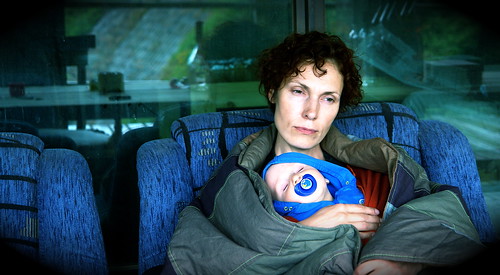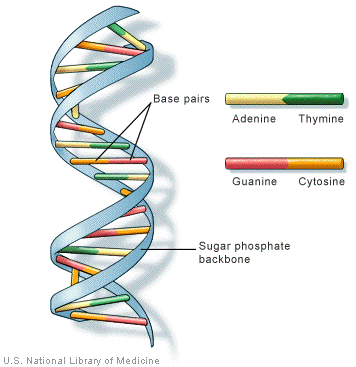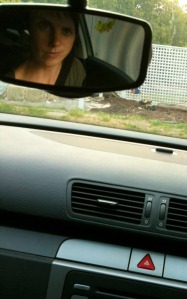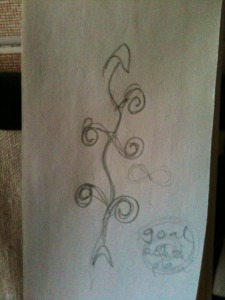Saturday 24 November 2012
Monday 19 November 2012
Reflection: the art of noticing
"What do you notice?"A small, but powerful question, when you involve people in some self-reflection.
We are putting together a workshop for mental health service providers at the end of the month and part of the process during the workshop is to encourage and support participants to 'stay with their hearts' and not to too quickly seek out solutions to issues raised during the workshop.
It's tricky to ask people to reflect when they are not always open to, nor experienced in, reflective processes - some are more naturally adept at reflecting than others.
The art of reflection can be viewed as the art of noticing. You can notice things around you by looking, hearing, feeling, tasting, and so on. You can also notice things within: what are you feeling? resisting? holding some tension about? loving? dreaming about?
Andrew LaRowe beautifully explains some of his noticing in his comment on Elizabeth Cottrell's blog post about noticing:
In all of my years of walking down the beach looking for seashells, I had never found a sharks tooth until the day someone taught me how to look for them. I remember the first one I found after that, and how easy it became to pick them out as I walked along. Within a few months and several trips to the beach, I literally had collected hundreds of sharks teeth. If a person can learn to see sharks teeth in the sand, then I believe we can guide ourselves to notice the many things in life that need not pass by like ships in the night (July 10, 2011).How do you cultivate this process of noticing? Practice, practice, practice! Nothing is more habit-forming than practicing something regularly.
 Paper, Pen, Post by margoc.
Paper, Pen, Post by margoc.Throughout this project, I've come to rely on our team meetings and phone conversations as a way to stay with the process and its emergent nature, as it keeps me in a 'noticing mode'. It keeps me connected and open to ideas (or the echo of ideas, that is, before they fully form and come into view). I have also taken up my pen and paper journaling again, which has really added another dimension to my process of reflecting (and 'staying with the question' - whatever that has come to mean for me from time to time).
Often there's a crossover between reflection and feedback. While these two processes are useful together, there's a need to be careful not to mix them up. Feedback is more about returning information in a situation (think of feedback in a sound system, for example). I explain reflection further on in this post.
There's also parallels between reflecting and debriefing. Again, you need to be aware of when you are reflecting and when you are debriefing.
I like to think of debriefing as a time to download and outwardly express thoughts, feelings, concerns, experiences. How do you think that went? What did you notice about X's reaction? It was good you prompted me when..., and so on. There's an instructive sense to debriefing, as in gaining knowledge and understanding.
Reflecting tends to be more inward: what will I take away from this experience? How will I connect this to future activities? What does this mean for me in the bigger picture? How would I do things differently next time? What did I notice about me? There's a consequential sense to reflection, as in deepening understandings and follow-on actions.
The debrief unpacks to experience; the reflection connects it to the bigger picture.
And so, here's Elizabeth Cottrell's question to finish:
What do YOU notice? What do you think it’s saying about who you are and what you value?
Some further reading:
Jennifer Stanchfield, 2011, Reflective Practice Versus Debriefing, The Inspired Educator Blog.
URL: http://www.experientialtools.com/2011/02/19/reflective-practice-versus-debriefing/
Joanne Roebuck, 2007, Reflexive practice: to enhance student learning. Journal of Learning Design, 2 (1). pp. 77-91.
URL: http://eprints.jcu.edu.au/2764/1/2764_Roebuck_2007.pdf
Prpic, J. (2005) Managing academic change through reflexive practice: A quest for new views. Research and Development in Higher Education, 28, 399–- 406.
URL: http://julianakaya.posterous.com/managing-academic-change-through-reflexive-pr
Labels:
blogs,
debriefing,
feedback,
noticing,
practice,
reflections,
self-reflection
Friday 14 September 2012
Views from the inside: A heuristic inquiry
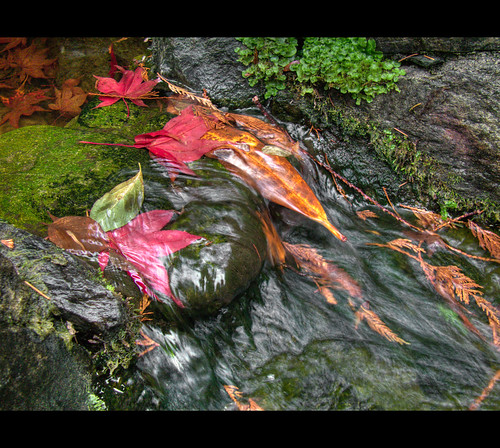 |
| Time flows on... Evan Leeson (Flickr) |
This whole train of experiencing, and the meanings that I have thus far discovered in it, seem to have launched me on a process which is both fascinating and at times a little frightening. It seems to mean letting my experiences carry me on, in a direction which appears to be forward, toward goals that I can but dimly define, as I try to understand at least the current meaning of that experience. The sensation is that of floating with a complex stream of experience, with the fascinating possibility of trying to comprehend its ever-changing complexity. --Carl Rogers, 1952I like this note from Rogers' essay. For me, it goes to the heart of what we experience and how we learn through our experiences (given experiential learning theories are most often based on Rogers' work). It also reminds me of one of the presentations from the ALARA conference held in Sydney last week, where Joy Murray, one of the presenters, talked about her use of Cybernetics to best describe her own experiences in the world. She made the point that we knit our use of theories and research to our direct lived experiences as a way to help us explain, or give some language to what we experience and how we make meaning of those experiences. We can only ever really account for our own experiences, others account for their own, in their own way, as they need to.
Joy was co-presenting with three community members with whom she had been working to develop a leadership program that was built on community needs and driven by community wishes (i.e. a community steering group was set up to "manage" the program itself). The project was a great example of supporting emergent community needs, developing empowered people and addressing issues at the local level.
As I've worked on this Aboriginal mental health service provision project over the last 8 months, I've come to focus more and more on my personal journey as a "researcher". I remember saying early on in the year (e.g. Brown's TED talk resonated strongly with me) that I expected to be changed in some way by working on the project. And as Rogers says, realising the "sensation ... of floating with a complex stream of experience, with the fascinating possibility of trying to comprehend its ever-changing complexity"!
We cannot ignore our experiences, most especially when we "research". Dave Hiles begins his 2001 essay, "Heuristic Inquiry and Transpersonal Research", with a quote from Braud and Anderson (1998, p.3):
Many of the most significant and exciting life events and extraordinary experiences - moments of clarity, illumination, and healing - have been systematically excluded from conventional research.I have heard it said that to do research that is sustainable and transformative, the research must "own us". Bruce Douglass & Clark Moustakas (1985) call heuristic inquiry "the internal search to know".
And so I enter - more knowingly than ever before - a journey of heuristic inquiry.
Further reading
Smith, MK (1997, 2004) 'Carl Rogers and informal education', the encyclopaedia of informal education. [www.infed.org/thinkers/et-rogers.htm. Last update: May 29, 2012]
Rogers, C & Freiberg, HJ (1993) Freedom to Learn (3rd edn.), New York: Merrill
Joy co-published a book with the abovementioned community members, which captures their own experiences of the community leadership project:
Murray J, Rash J-L, Creaton R, Cooley P and McClelland D (2009), Views from the inside: Participant Perspectives on Community Leadership. CommonGround Publishing Pty Ltd., Victoria.
More about the book:
In so doing the book explores the relationship between: one person's theory; a community development program in practice; and real life experience. It does this not through a voice of authority commenting on people's lived experience and attempting to relate this to the theory, but by showing what the program meant to the project leader and what it meant to each of the four participants. It tries to demonstrate, but not explain, how these disparate meanings connected, or otherwise, with the theory that the project leader believed she was applying; and how in the end all knowledge is personal, built up over a life time and stitched together with the threads of our relationships in whatever environment we happen to inhabit.Hiles, D (2001), Heuristic Inquiry and Transpersonal Research, paper presented to CCPE, London UK, October 2001. Available: http://psy.dmu.ac.uk/drhiles/HIpaper.htm
Braud, W & Anderson, R (Eds) (1998) Transpersonal Research Methods for the Social Sciences: Honoring human experience. Sage
Douglass, B & Moustakas, C (1985), Heuristic inquiry: the internal search to know, Journal of Humanistic Psychology, SUMMER 1985, vol. 25, no. 3, 39-55
Moustakas, C (1990) Heuristic Research: Design, methodology and applications. Sage
Labels:
ALARA,
conferences,
heuristics,
inquiry,
journeying,
Moustakas,
projects,
TEDtalks
Tuesday 28 August 2012
Learning design and inquiry into teaching and learning
I've begun curating a topic on Scoop.it called "Learning design and inquiry into teaching and learning".
The theme is: How do we learn? Teach? Design for learning? What makes learning memorable, sustainable and effective?
I'm particularly interested in learning design research in its many guises, along with commentary and critique around learning design issues and theories.
If you have suggestions and would like to share them, please do!

The theme is: How do we learn? Teach? Design for learning? What makes learning memorable, sustainable and effective?
I'm particularly interested in learning design research in its many guises, along with commentary and critique around learning design issues and theories.
If you have suggestions and would like to share them, please do!

Tuesday 21 August 2012
2012 Action Learning, Action Research Association (ALARA) Conference
The Action Learning, Action Research Association (ALARA) annual conference is less than three weeks away. It will be held at the Sebel Hotel in Sydney over two days, 3rd and 4th of September, 2012.

This year's conference focuses on "Achieving Sustainable Outcomes through Dialogue and Engagement" and the presentations cover a wide range of topics.
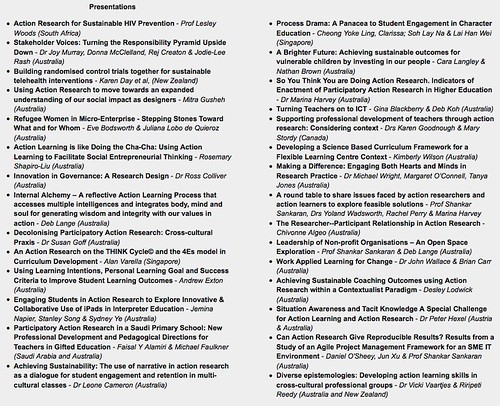
I am presenting with my project colleagues, Dr Michael Wright and Tanya Jones, along with some of the community members with whom we've been working over the last 7 months. Our presentation will reflect the process through which we've engaged community members to talk more deeply about the issues they've faced to do with mental health service provision. We will set the scene for conference participants to experience a little of what we've attempted during the community group sessions and hope we will also learn from their participatory action research (PAR) experiences!
I've been an ALARA member now since 2005 and have found the Association to be incredibly supportive of its members. As always, conferences enable networking and (re)connections that help to both sustain the Association as well as AL and AR practitioners, and to share their work and experiences in (and of) the field.
Hope to see you there!

This year's conference focuses on "Achieving Sustainable Outcomes through Dialogue and Engagement" and the presentations cover a wide range of topics.

I am presenting with my project colleagues, Dr Michael Wright and Tanya Jones, along with some of the community members with whom we've been working over the last 7 months. Our presentation will reflect the process through which we've engaged community members to talk more deeply about the issues they've faced to do with mental health service provision. We will set the scene for conference participants to experience a little of what we've attempted during the community group sessions and hope we will also learn from their participatory action research (PAR) experiences!
I've been an ALARA member now since 2005 and have found the Association to be incredibly supportive of its members. As always, conferences enable networking and (re)connections that help to both sustain the Association as well as AL and AR practitioners, and to share their work and experiences in (and of) the field.
Hope to see you there!
Sunday 12 August 2012
Virtuous cycles: (Re)building culture through authentic relationships

Yesterday I went to a panel discussion at the Telethon Insitute for Child Health Research, which featured four researchers, including Canadian researcher Professor Michael Chandler, who work in the area of Aboriginal health and wellbeing. Collectively, they are seeking to change the way our health systems and, more broadly, our society supports and acknowledges Aboriginal culture as vibrant, real and necessary for the health and wellbeing of Aboriginal people (especially in Australia, as reflected by the panel members). Other panel members were Assoc Professor Cheryl Kickett-Tucker, Assoc Professor Juli Coffin and Dr Michael Wright.
In addition, I recently watched this interview with Professor Taiaiake Alfred (Canada), who also talks about the need to rebuild culture in order for Aboriginal people to thrive. Both Alfred's interview and the panel discussion highlighted the ways in which colonisation has heavily impacted on the wellbeing of Aboriginal peoples.What has recently emerged for me too across these and other discussions, is the idea of "virtuous cycles", where one good deed is reciprocated by another good deed (as opposed to a "vicious cycle" let's say). This notion also fits the cyclical action research model where one action informs subsequent actions, observations and reflections in an ongoing cycle of iterative development and inquiry, to bring about positive social change.
This is more than undertaking analysis and answering a question: it is, as the panel members described yesterday, a heartfelt response to a community's wishes for help and support in ways that help them to grow, feel empowered and develop stronger cultural links. There's a great personal commitment to undertaking research of this kind, as it impacts on the researchers' own communities and families. It's engaging our right brains to develop our whole self through community based participatory research. There's a symbiotic relationship between research and living, community and culture, and also between Aboriginal and non-Aboriginal people, potentially, as we come to understand that our own quality of life is linked with that of others, as realised in Watson's quote:
If you have come here to help me, you are wasting your time. But if you have come because your liberation is bound up with mine, then let us work together. ~Aboriginal activists group, Queensland, 1970s.I wished there were policymakers and government staff in the room yesterday who would have heard first hand the work these researchers are doing and how they were doing it. There's a strong focus on developing relationships both with communities and with government departments and service providers (particularly in the case of Dr Wright's project, on which I'm also working), and a heartfelt commitment to truly listen to the community's wishes and needs, as well as understanding the time it takes to grow such work (which is counter to the funded project habit of finishing up in one or two years, for example).
All the panel members are doing such great work and making a difference in their communities. If governments were this committed imagine how much could be achieved!
Professor Chandler used the phrase, "cultural wounds need cultural medicine", a number of times during the discussion which resonated strongly with those present. It says much about how non-Aboriginal culture needs to support more positive impressions of Aboriginal culture instead of the negative stereotypes and discrimination we are more familiar with today. Cheryl Kickett-Tucker mentioned this yesterday saying that such stereotyping supported misguided 'rites of passage' by Aboriginal youth reconfirming such stereotypes, as a way to confirm their Aboriginality - what a sad indictment on our society that it has come to this? Juli Coffin also confirmed the impact of stereotypes in her work and in fact both researchers have been working with kids to uncover aspects of school bullying and its links to racism and cultural identity. Coffin said that some Aboriginal kids they spoke to had no positive cultural experiences at school, yet it is essential to a child's wellbeing to develop positive cultural impressions in those vital early years. Interestingly too, there is no Aboriginal word (in the region Coffin works) for 'bullying' - it's a white man's word.
Aristotle said, "Hope is a waking dream'. By asking challenging questions and inquiring into why things are the way they are, yesterday's panel members, along with Professor Alfred and many, many likeminded others challenge non-Aboriginal people to "wake up" to the situation and be a part of a new era that sees us all participate in deconstructing the effects of colonisation, so that we all can become better people, in a culturally secure and just society.
Some further reading
Coffin, J (2007).Rising to the Challenge in Aboriginal Health by Creating Cultural Security, Aboriginal and Islander Health Worker Journal, Volume 31 Issue 3 (May/June 2007).
URL: www.solidkids.net.au/images/uploads/articles/rising-jcoffin.pdf
Guilfoyle, A, Coffin, J & Maginn, P (2008), Chapter 10 Make sure there is a shady tree: Participation and action research with Australian aboriginal communities. In Paul J. Maginn, Susan M. Thompson, Matthew Tonts (ed.) Qualitative Urban Analysis: An International Perspective (Studies in Qualitative Methodology, Volume 9), Emerald Group Publishing Limited, pp.213-240.
Wright, M (2011). Research as intervention: Engaging silenced voices, Action Learning, Action Research Journal, Vol 17, No 2.
Abstract: http://journal.alara.net.au/index.php/alarj/article/view/5
Kickett-Tucker, C & Coffin, J (2011). Aboriginal self-concept and racial identity: Practical solutions for teachers. In N. Purdie, G. Milgate & H. R. Bell (Eds.), Two way teaching and learning (pp. 155-172). Camberwell, Victoria: Australian Council for Educational Research.
Chandler, M & Lalonde, C (2008). Cultural Continuity as a Protective Factor against Suicide in First Nations Youth. Horizons --A Special Issue on Aboriginal Youth, Hope or Heartbreak: Aboriginal Youth and Canada’s Future. 10 (1), 68-72.
URL: http://www2.psych.ubc.ca/~chandlerlab/Chandler%20&%20Lalonde%20(2008).pdf
Chandler, M, Lalonde, C, Sokol, B & Hallett, D (2003). Personal persistence, identity development, and suicide: A study of native and non-native North American adolescents. Monographs of the Society for Research in Child Development, Serial no. 273, 68 (2).
URL: http://www2.psych.ubc.ca/~chandlerlab/Chandler,%20Lalonde,%20Sokol,%20&%20Hallett%20(2003).pdf
Professor Taiaiake Alfred: http://taiaiake.posterous.com/ [Lots of accessible work, publicly available.]
Monday 25 June 2012
The story of journeying
We've been talking about journeying as we develop the Framework which is key to our project (especially over that past month). Certainly the Journey Towards Reconciliation has been discussed a number of times in our sessions. Check out some of the Reconciliation stories here (in particular, check out this one).
One of the research team described the double helix (DNA) as a visual metaphor for journeying and going on a shared journey.
Doing a quick search on the web for 'journeying' has resulted in books, blogs, websites and news that centres on spirituality and spiritual journeying. There's an obvious connection with spirituality and undertaking a journey of the Self based on belief, healing and wellness. It is deeply reflective and personal, but also engages the individual with community in the sense of pilgrim, travel and arrival. There's a sense of adventure and pushing the boundaries whether physical or personal/spiritual - traveling across landscapes and time and space.
There's also some scholarly work on the research journey, in particular participatory action research. For example, the opening lines of this particular article about PAR by Carol Stuart (1998) read as follows:
Robert Frost said it best:
The Road Not Taken
Two roads diverged in a yellow wood,
And sorry I could not travel both
And be one traveler, long I stood
And looked down one as far as I could
To where it bent in the undergrowth;
Then took the other, as just as fair,
And having perhaps the better claim,
Because it was grassy and wanted wear;
Though as for that the passing there
Had worn them really about the same,
And both that morning equally lay
In leaves no step had trodden black.
Oh, I kept the first for another day!
Yet knowing how way leads on to way,
I doubted if I should ever come back.
I shall be telling this with a sigh
Somewhere ages and ages hence:
Two roads diverged in a wood, and I--
I took the one less traveled by,
And that has made all the difference.
I'll leave this with you - a beautiful example of the story of the spiritual journey!

One of the research team described the double helix (DNA) as a visual metaphor for journeying and going on a shared journey.
Doing a quick search on the web for 'journeying' has resulted in books, blogs, websites and news that centres on spirituality and spiritual journeying. There's an obvious connection with spirituality and undertaking a journey of the Self based on belief, healing and wellness. It is deeply reflective and personal, but also engages the individual with community in the sense of pilgrim, travel and arrival. There's a sense of adventure and pushing the boundaries whether physical or personal/spiritual - traveling across landscapes and time and space.
There's also some scholarly work on the research journey, in particular participatory action research. For example, the opening lines of this particular article about PAR by Carol Stuart (1998) read as follows:
This paper explores the ethical dilemmas involved in Participatory Action Research (PAR), an adventurous research process that creates meaningful change in the lives of those who are engaged in the research.Closely related to journeying I think is storytelling. The telling of the journey, or indeed within the journey itself. The oral record of travel, of landscape and a point or points in time. A recognition of relationship to place and others through an emotional expression artfully told. An acknowledgement of our connection to others and to place, inextricably linked by the journeying experience; a shared learning and living.
Robert Frost said it best:
The Road Not Taken
Two roads diverged in a yellow wood,
And sorry I could not travel both
And be one traveler, long I stood
And looked down one as far as I could
To where it bent in the undergrowth;
Then took the other, as just as fair,
And having perhaps the better claim,
Because it was grassy and wanted wear;
Though as for that the passing there
Had worn them really about the same,
And both that morning equally lay
In leaves no step had trodden black.
Oh, I kept the first for another day!
Yet knowing how way leads on to way,
I doubted if I should ever come back.
I shall be telling this with a sigh
Somewhere ages and ages hence:
Two roads diverged in a wood, and I--
I took the one less traveled by,
And that has made all the difference.
I'll leave this with you - a beautiful example of the story of the spiritual journey!
The storm approached – and I approached the storm; we were destined to meet, when all of a sudden I became aware of a lifting of the dark clouds and a lightening of the far horizon. Amazingly the rain and wind’s path changed direction a little to the north and was moving past me, not towards me any more. At that point my own path into the wind was able to change and with the threat now past I could turn away from the sea and back into the sand-dunes. Here I raised the woollen muffler from my ears and as I did so a sound pulled my attention back to the shoreline; my Oystercatcher, my constant Companion, gave a shrill cry and flew away northwards out of sight.

Leave by ·BigGolf·
Labels:
images,
journeying,
poetry,
Reconciliation,
spirituality,
stories,
storytelling
Saturday 5 May 2012
Once upon a story: Storytelling, analogies and metaphors
There are many cultures on earth, each with rich traditions, customs and opportunities for storytelling. All these forms of storytelling are valuable. All are equal citizens in the diverse world of storytelling (National Storytelling Network).It has occurred to me for some time now that stories are powerful tools to convey that which is often hard to describe, explain, or sell.
Photo by M O O M O O !
Along with stories, metaphors and analogies are equally powerful tools and the three often work together. As we draw ever closer to an ideal mental health service model, I wonder how we can best convey, indeed pitch, the model to the project stakeholders.Story as vision
Stories connect people to other people and to place, to the land and sea. Like the songlines of the Aborigines, stories map a place in a way beyond symbols and geography (Scott Edward Anderson).How do we ensure the story holds up? Is the use of metaphor adequate? How do you keep the primary message clear? And what of multiple metaphors and analogies to tell the same story? We also need to come to some consensus on the shared story.
The model we are developing is taking shape much like an organism you could say, something that sits in cupped hands, lovingly held, like a flower unfolding. The layered petals add depth both to the metaphor and to the model - and so the analogy builds.
Story as explanation
When people hear stories about people they can identify with, the people in the stories become role models and their peers are encouraged to behave the same way. Such stories tend to be repeated and their lessons are spread (Kim Harrison).What does it take to tell a great story? I came across this essay, The Healing Potential of Metaphor in the Narrative (2001), when searching for relevant mental health projects. The metaphor of water is used here in the "tidal model", an analogy of the ocean and one sailing on a wellness journey. When confronted by pirates (i.e. a health crisis) one must find a way to recover...and so on it goes. Reading about this model got me thinking not only about the power of narrative approaches, but how one must commit entirely to such a process - there's nothing more distracting and drab as a half-baked story!
Story as process
The most popular functional areas in which storytelling was used were envisioning and goalsetting, reframing a situation and building self esteem. A smaller number [of coaches] said that they used stories to help with such issues as problem solving, empowerment and achieving success. (Margaret Parkin).How might story be best used in our research project? Stories can explain, captivate, mobilise and remind. What would our (research) story achieve for us? At this point it would necessarily explain and perhaps more importantly mobilise people into action to bring about much needed change in the provision of mental health services (particularly to Aboriginal people).
A whole range of stories would also help to support the model in explaining each of its components in relation to Aboriginal people and their experiences (good and bad) of mental health services. These types of stories are hard to ignore when they come from direct lived experience.
To date we have used story techniques in our group work, including the role play scenarios, in addition to "elevator stories" and yarning. All have produced tangible outcomes and promoted deep thinking. And, as we draw nearer to an outcome, story may serve us well as part of our consensus and "sign off" process.
Friday 6 April 2012
Mapping contexts, mapping meanings
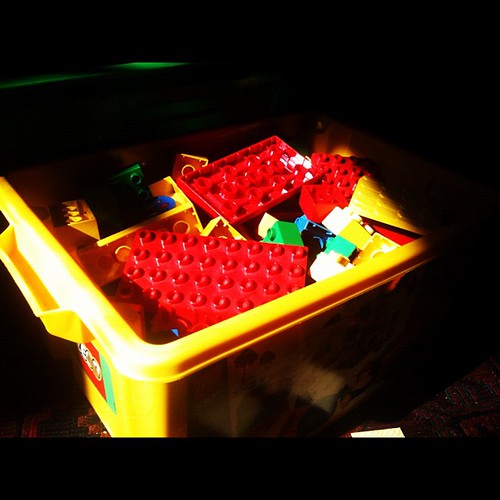 Image: margoc
Image: margoc Image: margoc, 2005.
Image: margoc, 2005."The great pleasure and feeling in my right brain is more than my left brain can find the words to tell you." — Nobel Laureate Roger Sperry.Our bodies often carry out actions and hold feelings and intuition in ways words cannot describe. Are you the type of person who cleans out your oven when you have something on your mind? I know I am! Our bodies "just know".
The session was hard work for all. I'm not sure we could have covered the territory we did in another way without taking a considerable amount of time, something we just do not have unfortunately. I took along some blocks and others made the most of objects around them. Some built a service model while others "performed" in their 3D context with much feeling. What a dynamic space it was! As with role plays, it takes a good deal of trust to expose oneself to this level of engagement and I'm so grateful that participants trusted the process we had invited them to engage in.
I came across some projects where 3D mapping was used to engage communities to define problems in their environment and develop community-based solutions. The Gaia Foundation is one such organisation who is working with communities using a participative 3D mapping (P3DM) process, and with multi-faceted and transformative outcomes.
The making of the 3D map is all part of a vital process of oral storytelling around the history and meanings of the landscape. It is through these stories that indigenous knowledge - often almost completely lost or forgotten - is given space to re-emerge. The knowledge and memory of the Elders suddenly becomes critical to the process, thus validating it's worth in the eyes of the young whilst reinvigorating confidence in the Elders. The whole journey is a unifying participatory experience for the community; everyone is at the table, every voice is heard and decisions are made together (Gaia Foundation, 2010).

3D mapping can help to expose the many layers within an issue, or "wicked problem", which, when told through story, provides immediate connection, relevance and intrinsic value. Story, action and engagement are powerful tools critical to bringing about change.
When asked to feedback about the participatory mapping process in the abovementioned Ethiopian project, one villager wrote this:
“The P3DM process enables the community to look at itself using the model as a mirror” [my emphasis].
It seems that reflection is also critical to the process of change. One sees the landscape through an alternate lens and in a way that is possibly less threatening than real life where community and cultural roles, conventions and politics can crowd out more reflective processes.
Further reading
Rambaldi, G., Muchemi, J., Crawhall, N. & L. Monaci, (2007) Through the Eyes of Hunter-gatherers: Participatory 3D Modelling among Ogiek Indigenous Peoples in Kenya, Information Development, Vol. 23, Nos 2/3, 113-128.
Stefano di Gessa (2008) Participatory Mapping as a Tool for Empowerment: Experiences and Lessons Learned from the ILC Network. Report, International Land Coalition, March 2008.
Jon Corbett, et al. (2010) Participatory mapping and communication: A guide to developing a participatory communication strategy to support participatory mapping, International Fund for Agricultural Development (IFAD).
Stefano di Gessa (2008) Participatory Mapping as a Tool for Empowerment: Experiences and Lessons Learned from the ILC Network. Report, International Land Coalition, March 2008.
Jon Corbett, et al. (2010) Participatory mapping and communication: A guide to developing a participatory communication strategy to support participatory mapping, International Fund for Agricultural Development (IFAD).
Saturday 10 March 2012
What role does the camera play?
I've been sitting with the Magee article I posted last month and reflecting on why it grabbed me and have realized that this article, along with the video clip by CineMatic Orchestra in a later post, highlights the role the camera plays in our ability to ask questions.
Magee herself questions her position as a photographer, which in turn pushes her to take brave steps in her work, as does Vertov in his attempts to present "truthful cinema". In the edited clip, Vertov brings the camera (and cameraman) into the scenes which is a question in and of itself - what IS the camera? What is it doing? How does it relate? What does it achieve?
The inclusion of the camera in the scenes invites critique.
This also appears to have been the case when we recorded the role play scenarios in our sessions. The scenarios took on a different "edge" when the group understood the scenarios would be recorded. Perhaps something about the finality of a recording? The spotlight on those in the role play? The "here and now" captured for posterity?
I'm keen to see what the reactions are when the second, "group-directed" scenario is played back in our next session! Will people want to see it? Will previous discussions be reopened? Emotions rekindled? Memories rewound? New discoveries made, more questions asked?
What further purpose will our recorded scenarios have in our developmental process? I wonder!
Friday 9 March 2012
Building scenarios using participative methods
There is no happiness if the things we believe in are different than the things we do. -- Albert Camus, Philosopher, Writer (in Reed & Kolibar 1995).

In a previous post I mentioned our use of recorded role play scenarios in our group sessions. Here I'll elaborate on our role play process and reflect on its effectiveness in our project so far.
Firstly, a brief background on role play scenarios. Role plays have been used as a group facilitation method across a range of contexts for some decades. Role plays have been utilised in education, therapy (e.g. psychodrama and sociodrama), business and leadership, community development, even computer based role-playing and simulation games and various other spaces where reflection and discussion take place for the purpose of learning, development and transformation.
Our first role play scenario displayed what a mental health service should NOT do when dealing with a client (in this case in a phonecall). Participants are all too familiar with this scenario!
Our second role play scenario displayed what a service MUST do when supporting a client (again in a phonecall). The role play scene was refined to capture the "first point of contact" between the service and the (potential) client.
To attempt a definition, a role play is
a staged and emotive encounter which delves into issues and problems people experience in their lives (or the lives of others). Role plays offer participants an opportunity to reflect on complex situations with multi-layered meanings, factors and issues. They enable a group to "spotlight" these complexities so as to make them more accessible in order to address them.In our case, and particularly with the second role play we held in our last group session, we invited the group members to be "directors" of the role play; that is, offering suggestions to the actors on how they might improve the scene and thus display the "ideal service" they could hope for. This meant stopping and starting the scene to incorporate the suggestions as discussed by the group. Some of these discussions were wide ranging, vigorous and emotive.
Reed and Kolibar (1995) present a similar technique but go a step further to suggest a participant tap the actor on the shoulder and step into the scene, replacing the actor from that point, acting out what they think should occur in the scene. This reflective technique, while emotional charged, is also a way to draw on people's ability to connect with issues and commit to - indeed invest in - seeking solutions to them.
Did the process work for us? Yes, I think it did. With more than an hour of discussion, we ended up with about 7 minutes of unedited, cut together footage, but the real outcome was the way the group moved to resolve some of the key element they saw were necessary for a relevant, high quality mental health service. The role play technique certainly supports the participatory process we've undertaken to use in the project, as this quote from Reed and Kolibar (1995) demonstrates:
Participants are challenged to develop potential solutions to the identified problem and then try out their comfort level in implementing the solution. In the process participants can realize the strengths and weaknesses of the proposed solutions, and may discover new facets of the problem. [my emphasis]Could we have achieved this in other ways? Most probably, but I would argue that we may not have done so as quickly! The level of commitment of the group members was highly apparent. And, as one member stated, this process (of using role plays) was real and authentic! So too, as a facilitator in this process, I was mindful of the vulnerability of the actors as much as of the group members. It is necessary to ensure the space remains a safe one in which all can explore and confront the issues at hand, in ways that best suit them. To juggle such interactions is tricky and group protocols are necessary to have in place beforehand, so all can respect the space and its purpose ahead of such emotive interactions.
Such is the emergent and liminal nature of participatory action research!
Tuesday 28 February 2012
Role of the (movie) camera: truthful cinema?
A montage of sound and image - sound from CineMatic Orchestra and image from Dziga Vertov's 1929 film, an attempt to capture cinéma vérité.
Am exploring the inter-web for the role and "eye" of (through? behind? with?) the camera through video and photography as a sideline to the project and our use of video scenario recordings. It has been a contested notion ever since film come into being!
Will explore more then synthesise later. :o)
"It is far from simple to show the truth, yet the truth is simple." Dziga Vertov[youtube http://www.youtube.com/watch?v=vvTF6B5XKxQ]
Am exploring the inter-web for the role and "eye" of (through? behind? with?) the camera through video and photography as a sideline to the project and our use of video scenario recordings. It has been a contested notion ever since film come into being!
Will explore more then synthesise later. :o)
Thursday 23 February 2012
Transformative development
We had our third planning meeting yesterday which was really energising - what a talented bunch I'm working with. :o)
As part of our facilitation, we've begun using video scenarios to delve deeper into the elements discussed by the group with some promising outcomes. Using this approach seems to move people away from their recognized positions and experiences to a place where they are almost bodily present; experiencing the moment in the scenario itself. This seems to release them of their "duty", perhaps, to their everyday roles and baggage.
It certainly resulted in a very energized group discussion within which I felt I also experienced - and witnessed - yarning (see Bessarab & Ng'andu 2010). The conversation was like a dinner conversation, was how one participant put it.
With regard to the scenario itself, we opted to display "how not to do things", so in our next session we will focus on "how things could be done" to achieve better outcomes.
And on a reflective note, this image is one that sparked a mini epiphany for me, as following our last session, I've felt in a bit of a wallow - not sure why, but mentioned this to the team during our planning and was provided with the following advice:
"Revisit the haze and stay with the question."
Really, this is the essence of PAR in process! The image marks a turning point in my thinking about transformative processes which can enable real change and encourages - no, insists upon - an active and authentic partnership between service providers and the people they serve in our communities.
Now to hold this space and remain present with the group as they - we - continue to develop and explore.
Tuesday 21 February 2012
Tuesday 7 February 2012
In reading mode . . .
It's tricky to post whilst caught in a heap of reading and process - it is a liminal place to be really! Until there's a "pit stop" or the journey reaches some sort of conclusion or pause, it's not always apparent to write one's thinking until one has thought it out some more :o)
So, here's what I'm reading / watching:
1. Bessarab & Ng'andu (2010) Yarning about yarning as a legitimate method in Indigenous research, International Journal of Critical Indigenous Studies, Vol 3, No 1, 37-50.
Why? The research team has been discussing the idea of yarning and whether or not it should be a specifically articulated practice engaged with in the Community Steering Group sessions. More and more yarning is seen as a legitimate and rigourous data gathering method and implies a connection between researcher and participants, where both acknowledge a transformation can occur in each other. In prticualr, and as I'm just reading now, Bessarab and Ng'andu discuss collaborative yarning, one of four forms of yarning a researcher should be cognisant of when undertaking research wth Indigenous peoples. As we conclude our reading of this text, the team will come together to share our reflections and see whether or not we move forward with this method in some way (of course, then discussing it with the group participants).
2. Brene Brown, The Power of Vulnerability (TEDx Houston June 2010).
Why? I'm exploring and reflecting on the role of researcher especially from a PAR perspective. The notion of engaging the whole self in the research is powerful for me and I expect to be transformed by this experience. I'm also highly aware of my white fella role and baggage I bring with me, at the same time, I must own this rather than dismiss it, as it informs who I am and how I be. Brown's talk lends some further words and thinking around this.
http://video.ted.com/assets/player/swf/EmbedPlayer.swf
3. Closing the Gap Clearinghouse - Council of Australian Governments (COAG)
Why? Sifting through a range of published articles, reports and project websites that seek to address Indigenous disadvantage in Australia and include health and wellbeing in particular, provides me with the landscape in which our project operates (at least theoretically for the most part). Some articles I've sourced so far include:
So, here's what I'm reading / watching:
1. Bessarab & Ng'andu (2010) Yarning about yarning as a legitimate method in Indigenous research, International Journal of Critical Indigenous Studies, Vol 3, No 1, 37-50.
Why? The research team has been discussing the idea of yarning and whether or not it should be a specifically articulated practice engaged with in the Community Steering Group sessions. More and more yarning is seen as a legitimate and rigourous data gathering method and implies a connection between researcher and participants, where both acknowledge a transformation can occur in each other. In prticualr, and as I'm just reading now, Bessarab and Ng'andu discuss collaborative yarning, one of four forms of yarning a researcher should be cognisant of when undertaking research wth Indigenous peoples. As we conclude our reading of this text, the team will come together to share our reflections and see whether or not we move forward with this method in some way (of course, then discussing it with the group participants).
2. Brene Brown, The Power of Vulnerability (TEDx Houston June 2010).
Why? I'm exploring and reflecting on the role of researcher especially from a PAR perspective. The notion of engaging the whole self in the research is powerful for me and I expect to be transformed by this experience. I'm also highly aware of my white fella role and baggage I bring with me, at the same time, I must own this rather than dismiss it, as it informs who I am and how I be. Brown's talk lends some further words and thinking around this.
http://video.ted.com/assets/player/swf/EmbedPlayer.swf
3. Closing the Gap Clearinghouse - Council of Australian Governments (COAG)
Why? Sifting through a range of published articles, reports and project websites that seek to address Indigenous disadvantage in Australia and include health and wellbeing in particular, provides me with the landscape in which our project operates (at least theoretically for the most part). Some articles I've sourced so far include:
- Tsey, K; Every, A (2000) Evaluating Aboriginal empowerment programs: the case of Family WellBeing, Australian and New Zealand Journal of Public Health, v. 24 no. 5 Oct 2000, 509-51.
- Walker, Roger; Cromarty, Helen; Kelly, Len; St Pierre-Hansen, Natalie (2009) Achieving cultural safety in Aboriginal health services: implementation of a cross-cultural safety model in a hospital setting, Diversity in Health and Care, v. 6 no. 1, 11-22.
- Nagel, Tricia, Robinson, Gary, Condon, John, and Trauer, Tom (2009) Approach to treatment of mental illness and substance dependence in remote Indigenous communities: results of a mixed methods study. Australian Journal of Rural Health, 17 (4). 174-182.
Lean into the discomfort of the work.More reflections to follow!
Labels:
indigenous research,
liminal,
readings,
references,
TEDtalks,
vulnerability,
yarning
Saturday 4 February 2012
The 21st century toybox
Thursday 26 January 2012
Action inquiry resources
We had our first Project Community Steering Group meeting yesterday which really got my senses going (I don't know how else to put it; it was quite an emotional event for me and I was quite nervous leading up to it for a range of reasons). I'm really warming into this!
I'm collecting web resources about activist learning and development here on Delicious. I'd love to hear of sites you've used or seen that would be helpful too!
One article I've just read titled "Lucienne Roberts: A is for Activism" (2011) is a commentary by Roberts on the idea of design activism. She reflects on her work as a graphic designer and whether or not she sees herself contributing to activist movements and the social good.
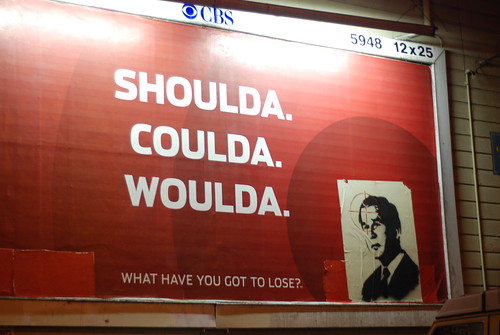
Image : Steve Rhodes (flickr)
I'm sensing that given the participatory nature of the Project, it seems logical to develop an activist education design approach in service to the participants. Not only logical, but it FEELS right. I'm seeing many connections between 'good' education design and participatory action research both in shared principles and similar practices.
Briefly, shared principles might include:
I'm collecting web resources about activist learning and development here on Delicious. I'd love to hear of sites you've used or seen that would be helpful too!
One article I've just read titled "Lucienne Roberts: A is for Activism" (2011) is a commentary by Roberts on the idea of design activism. She reflects on her work as a graphic designer and whether or not she sees herself contributing to activist movements and the social good.

Image : Steve Rhodes (flickr)
I'm sensing that given the participatory nature of the Project, it seems logical to develop an activist education design approach in service to the participants. Not only logical, but it FEELS right. I'm seeing many connections between 'good' education design and participatory action research both in shared principles and similar practices.
Briefly, shared principles might include:
- user participation and centredness
- collaborative design and development
- transformation and change
- emergent design (i.e. research design and ed design framework)
- critical reflection
- activism
- action inquiry
- ongoing consultation and feedback (dialogical)
- workshopping design elements using group processes
- developing mini scenarios and case studies
- (meta) reflection on the process(es)
- telling stories and active listening
- ensuring safe spaces to work together
Friday 20 January 2012
Re-emerging in 2012!
Well, a belated Happy New Year to you all :o)

Photo by bayasaa
After a hiatus designed by moving interstate and having kid number 2, life is returning to some kind of 'normal', and I have picked up a bit of work that is turning out to be most interesting!
My reflections on this work will appear here (minus any identifying information), but needless to say it is consulting on an education design facilitation framework/process for a participatory action research project in the area of Aboriginal health service provision. I'm really looking forward to getting stuck in and it's certainly a change from education design work within the education setting!
Whilst away from 'here', I have been blogging our gardening activities over here. But more to come here shortly...stay tuned :o)

Garden in flow...!

Photo by bayasaa
After a hiatus designed by moving interstate and having kid number 2, life is returning to some kind of 'normal', and I have picked up a bit of work that is turning out to be most interesting!
My reflections on this work will appear here (minus any identifying information), but needless to say it is consulting on an education design facilitation framework/process for a participatory action research project in the area of Aboriginal health service provision. I'm really looking forward to getting stuck in and it's certainly a change from education design work within the education setting!
Whilst away from 'here', I have been blogging our gardening activities over here. But more to come here shortly...stay tuned :o)

Garden in flow...!
Labels:
2012,
consulting,
family,
New Year,
projects,
reflections,
transitions
Subscribe to:
Posts (Atom)
